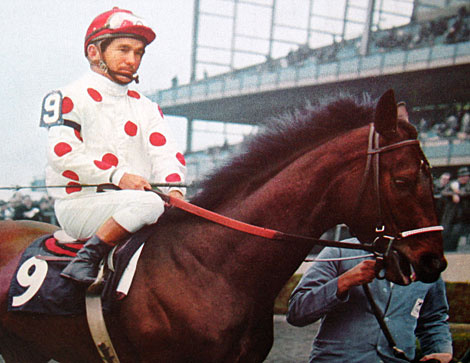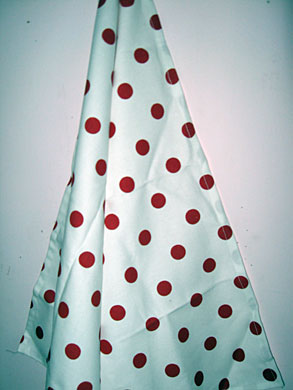As has been the custom the last few years, I spent Preakness day as guest of Thoroughbred owner Lee Einsidler in the International Pavilion in the infield, just a stone’s throw from the finish line and the Preakness winner’s circle.
I mention this only because of an odd piece of memorabilia I took home with me – a cloth napkin from our table. The reason I confiscated it was equally as odd. The napkin was white with red polka dots; virtually identical to the Belair colors of William Woodward and later his daughter Edith W. Bancroft.
Those colors are ingrained in the memory and still evoke images and feelings of a time long gone; of innocence, and the unbridled joy of victory, and the gut-pounding sadness of defeat, and butterflies in the stomach.
They are the colors of Damascus, the horse who started it all; who thrust me into a world I never knew existed; one of grace and beauty and boundless thrills. Boy, do I appreciate a horse like him today; a horse held together by sinews of steel, who raced 16 times at 3; who won at 10 different distances from six furlongs to two miles; who set track records under heavy imposts; who won the equivalent of 12 grade I stakes; who set a track record at Aqueduct under 130 pounds while making this third start in 16 days, all carrying 130 pounds or more; and whose intervals between races at 3 were 2 weeks, 3 weeks, 1 week, 2 weeks, 3 weeks, 10 days, 3 weeks, 1 week, 3 weeks, 2 weeks, 16 days, 26 days, 28 days, and 2 weeks…and he actually got stronger as the year went on.
It was Damascus who breathed life into a hollow existence, numbed from years of toiling mindlessly on Wall Street.
It’s been 45 years since that life-altering encounter with Damascus and Thoroughbred racing, and those colors still get to me. In fact, racing to a spellbound neophyte was a tapestry of colors – a kaleidoscope of rich hues and intricate patterns. I can still see them. The red silks and tartan sash of Dr. Fager. The black silks and red cap of Buckpasser. The dark grey silks, yellow braid, and yellow sleeves of Arts and Letters. The black and gold stripes of Majestic Prince. And the brown and white silks and Running W of Gallant Bloom. They were as identifiable as the noble steeds beneath them.
It amazed me that more than four decades later even a simple cloth napkin could rekindle those early flames and inspire the very words and feelings I now find myself expressing. Yes, it’s all about colors.
I have considered myself a friend of Paul Reddam’s for a number of years, but I no longer will be able to look at his white and purple colors that were once taken for granted and not see I’ll Have Another charging down the stretch in the Kentucky Derby and Preakness. It was those same colors that illuminated the Empire State Building on the Thursday night before the Belmont Stakes. Yes, it’s all about colors, from golden chestnuts to “blacks and bays, and dappled grays” and the familiar colors they carried to victory.
By now, most of you must be wondering why I am writing this. The truth is, I haven’t the slightest idea. It is 1:53 a.m., the Triple Crown has already begun to fade into memory, and after five months of raging Derby and Triple Crown fever, the door to the decompression chamber is slowly beginning to open. I’m just not ready to enter.
I’m not ready to say goodbye for good to I’ll Have Another. I’m not ready to let go of Bodemeister, Paynter, Dullahan, and Creative Cause until the summer. So, I look at my cloth napkin folded up on my bookcase and it becomes a portal to the past, unleashing a tidal wave of nostalgia, back to when a milkshake was something I drank at my corner candy store; when detention was for juvenile delinquents, not horses; when the word “positive” was positive; when the New York Times actually covered racing as a sport; when twitter was something I heard from the sparrows outside my window.
I realize this little journey into the past is only temporary, and my thoughts will soon turn to the Stephen Foster and Royal Ascot. But what’s wrong with having a cathartic moment now and then?
And what better inspiration than Damascus, and, of course, Dr. Fager and Arts and Letters and all those other horses who beckoned me to enter a new world that would sustain and nurture me the rest of my life?
Hey, what did you expect at two o’clock in the morning, Socrates?
Come to think of it, Socrates described the depth of observing even the simplest of objects, like a cloth napkin, a lot better than I ever could. He wrote: “I was afraid that by observing objects with my eyes and trying to comprehend them with each of my other senses I might blind my soul altogether.”

Damascus' Belair colors





